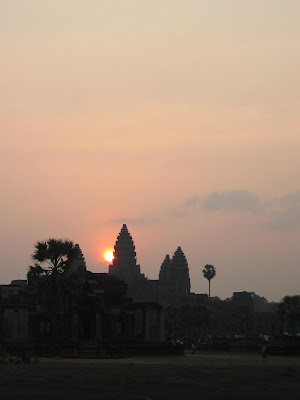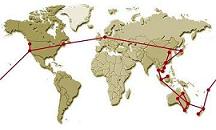
After settling down in our guesthouse at Siem Reap, we prepared ourselves for the visit to Angkor the next day. Here's some more info about Angkor for those of you that have never heard of it or just want to refresh their general memory (please note, several parts are taken from Wikipedia.org).

Between 900 and 1200 AD, the Khmer empire built some of the world's greatest architectural masterpiecies. Around 72 temples and other buildings were taken up just outside the town of Siem Reap (on the northern side of the Tonle Sap lake).

The main temple is called Angkor Wat and was built between 1113-1150 by King Suryavarman II. With walls nearly one-half mile long on each side, Angkor Wat grandly portrays the Hindu cosmology, with the central towers representing Mount Meru, home of the gods; the outer walls, the mountains enclosing the world; and the moat, the oceans beyond. The later capital of Angkor Thom, built after the Cham sack of 1177, has at its centre the Bayon. Construction of Angkor Thom coincided with a change from Hinduism to Mahayana Buddhism. Temples were altered to display images of the Buddha, and Angkor Wat briefly became a Buddhist shrine. A subsequent Hindu revival included a large-scale campaign of desecration of Buddhist images, before Theravada Buddhism became established from the 14th century.

During the 15th century, nearly all of Angkor was abandoned, except Angkor Wat, which remained a shrine for Buddhist pilgrims. While it is widely believed that this occurred after Siamese attacks, some recent research by Australian archaeologists indicates that the main cause was a shortage of water caused by during the transition from the medieval warm period to the little ice age.

Angkor was re-discovered by the French (late 19th century) who began an extensive restoration process (later joined by other countries like Japan and Korea) to recover the temples from the dense jungle that developed from the 15th century onwards.

We humble tourists only visited a relatively small part of Angkor's offerings: we first went to see the sunset over Angkor Wat at 6:00 am, had breakfast, subsequently visited (amongst others) Bayon, the Terrace of the Leper King, the Terrace of Elephants, Ta Prohm (featured in Tomb Raider and Two Brothers), and finished the day of with an extensive visit of Angkor Wat. We will disperse more facts and pics about these truly amazing sights in the upcoming post.
 After settling down in our guesthouse at Siem Reap, we prepared ourselves for the visit to Angkor the next day. Here's some more info about Angkor for those of you that have never heard of it or just want to refresh their general memory (please note, several parts are taken from Wikipedia.org).
After settling down in our guesthouse at Siem Reap, we prepared ourselves for the visit to Angkor the next day. Here's some more info about Angkor for those of you that have never heard of it or just want to refresh their general memory (please note, several parts are taken from Wikipedia.org).  Between 900 and 1200 AD, the Khmer empire built some of the world's greatest architectural masterpiecies. Around 72 temples and other buildings were taken up just outside the town of Siem Reap (on the northern side of the Tonle Sap lake).
Between 900 and 1200 AD, the Khmer empire built some of the world's greatest architectural masterpiecies. Around 72 temples and other buildings were taken up just outside the town of Siem Reap (on the northern side of the Tonle Sap lake).  The main temple is called Angkor Wat and was built between 1113-1150 by King Suryavarman II. With walls nearly one-half mile long on each side, Angkor Wat grandly portrays the Hindu cosmology, with the central towers representing Mount Meru, home of the gods; the outer walls, the mountains enclosing the world; and the moat, the oceans beyond. The later capital of Angkor Thom, built after the Cham sack of 1177, has at its centre the Bayon. Construction of Angkor Thom coincided with a change from Hinduism to Mahayana Buddhism. Temples were altered to display images of the Buddha, and Angkor Wat briefly became a Buddhist shrine. A subsequent Hindu revival included a large-scale campaign of desecration of Buddhist images, before Theravada Buddhism became established from the 14th century.
The main temple is called Angkor Wat and was built between 1113-1150 by King Suryavarman II. With walls nearly one-half mile long on each side, Angkor Wat grandly portrays the Hindu cosmology, with the central towers representing Mount Meru, home of the gods; the outer walls, the mountains enclosing the world; and the moat, the oceans beyond. The later capital of Angkor Thom, built after the Cham sack of 1177, has at its centre the Bayon. Construction of Angkor Thom coincided with a change from Hinduism to Mahayana Buddhism. Temples were altered to display images of the Buddha, and Angkor Wat briefly became a Buddhist shrine. A subsequent Hindu revival included a large-scale campaign of desecration of Buddhist images, before Theravada Buddhism became established from the 14th century. During the 15th century, nearly all of Angkor was abandoned, except Angkor Wat, which remained a shrine for Buddhist pilgrims. While it is widely believed that this occurred after Siamese attacks, some recent research by Australian archaeologists indicates that the main cause was a shortage of water caused by during the transition from the medieval warm period to the little ice age.
During the 15th century, nearly all of Angkor was abandoned, except Angkor Wat, which remained a shrine for Buddhist pilgrims. While it is widely believed that this occurred after Siamese attacks, some recent research by Australian archaeologists indicates that the main cause was a shortage of water caused by during the transition from the medieval warm period to the little ice age. Angkor was re-discovered by the French (late 19th century) who began an extensive restoration process (later joined by other countries like Japan and Korea) to recover the temples from the dense jungle that developed from the 15th century onwards.
Angkor was re-discovered by the French (late 19th century) who began an extensive restoration process (later joined by other countries like Japan and Korea) to recover the temples from the dense jungle that developed from the 15th century onwards.  We humble tourists only visited a relatively small part of Angkor's offerings: we first went to see the sunset over Angkor Wat at 6:00 am, had breakfast, subsequently visited (amongst others) Bayon, the Terrace of the Leper King, the Terrace of Elephants, Ta Prohm (featured in Tomb Raider and Two Brothers), and finished the day of with an extensive visit of Angkor Wat. We will disperse more facts and pics about these truly amazing sights in the upcoming post.
We humble tourists only visited a relatively small part of Angkor's offerings: we first went to see the sunset over Angkor Wat at 6:00 am, had breakfast, subsequently visited (amongst others) Bayon, the Terrace of the Leper King, the Terrace of Elephants, Ta Prohm (featured in Tomb Raider and Two Brothers), and finished the day of with an extensive visit of Angkor Wat. We will disperse more facts and pics about these truly amazing sights in the upcoming post.


No comments:
Post a Comment